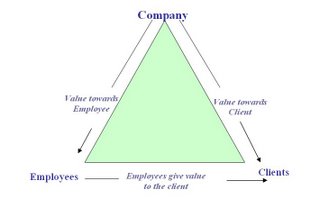Client Experience Management in Software Service Relationships
~ Harsh Vardhan
Till few years ago the primary market for Indian software companies was United States of America. Now organizations are diversifying to the relatively untouched soils of Australia, Europe (primarily Belgium, France, Germany and The Netherlands) and East Asia (Japan, China, Singapore, and The Philippines). The diversification of client engagements, nevertheless, adds color to one’s experience and work portfolio, but the challenges of meeting and exceeding client expectations in international contracts are probably a reason for nightmares for the Delivery Heads. A need to have an organized client experience management system in place has evolved, so as to maintain and improve the extent of Indian leadership in the Software outsourcing market.
Software Contracts
Software Service engagements are largely governed by Contracts. Contracts define the scope of work, the team headcount, time required and most importantly the process to be adopted for project development and implementation. Another important aspect of contract is the accountability of the defects and non-conformances. Consider an example, “ABC Inc. is into developing software products. It outsources a part of the software product development to another organization XYZ Ltd. XYZ delivers the deliverables on time to ABC. ABC checks and bundles the delivered piece of software to its product suite. However, when ABC releases the suite in the market, the end-users report bugs in the part, which was worked on by XYZ. In the mean time, the contract between XYZ and ABC has expired, or no longer holds. In this case the accountability of the bugs lies entirely in the hands of ABC for no fault of theirs. Such annoying situations discourage the conservative countries (most of the European region) to outsource their software jobs to India. Such instances can be averted and confidence of the European region can be gained by managing the client experience in a better way.
Managing the Client Experience
Client Experience can be managed only after thoroughly understanding client expectations. To outsource a job to a low cost country is not necessarily an indication that the client needs a low cost solution to benefit from the potential savings owing to the cost differential. What the client actually values may sometimes be drastically different from what is perceived to be of value to the client.
For example, while the software service provider may perceive that client values cost benefits; the client might be in a hurry to put the systems in place to meet a deadline without any regard to the cost incurred in achieving that. In this scenario, providing a low cost pricing for a software service delivered at a normal pace may be of little value to the client. What the service provider is expected to do is to provide a faster service by adopting a time saving process, may be at an additional cost.
Coming out of Process Paralysis
Another aspect of client experience management is the dynamic nature of expectations in long-term engagements. A software service provider might have acquired a long-term contract on the basis of, say, SEI CMM Level 5 competence. However, providing CMM level 5 compliant solutions all the time may not be the right thing to do. For a particular phase to be completed as part of an ongoing long-term relationship in less-than-normal time, the service provider should have the ability to adopt a faster process like Agile Methodology.
This leads us to another syndrome very often seen in the Indian software Industry, which I call process paralysis. Indian Software companies are rushing towards CMM compliant processes, ISO certifications, Six Sigma methodologies and many other process management initiatives. While these competence initiatives help to a great extent in adding credibility and convincing the prospects about a better and consistent level of service quality; the irony of the industry is that most client engagements are driven by client-driven processes. Therefore, the service provider, even though being at CMM Level 5, may be asked by the client to follow its own internal project development processes.
In that scenario, the employees become blind followers of the client’s processes. The prevailing perception among employees, including their project managers, is that “in order to gain client confidence and achieve desired service value deliverance, conformance of client processes is the best thing to do.” This is not always true!
I have myself experienced this process paralysis while working for one of the CMM Level 5 Indian software majors. Our client then was a major travel solution provider in the USA seeking some software testing services. We were bound to follow the client’s processes as per the terms of contract. However, while providing the testing services, the Configuration Management tool was at client’s network and we had to send all the artifacts as fresh emails for uploads to that tool as we were not given sufficient access privileges for data secrecy reasons. As the project progressed, what resulted was a heap of similar documents having similar content without having a version control in place. We decided to develop a Traceability matrix for all the artifacts. It was a seemingly impossible task at the face of it. The unanimous solution, which came to our sight, was to compile all the documents and give a fresh revision number to them and upload in a systematic manner in our own Configuration Management tool and share that database to the client. It took us 5 days to bring everything in place.
The learning in the case: Had we been proactive enough to convince the client to have a strict version control at our end in place, the scenario would never have occurred. At times, going out of contract norms is a way to provide more value to the client.
Please employees to please clients
Managing employee value in order to manage client value is the key to successful software contract engagements. It has been proven that most client defections are due to unsatisfied employees sitting at the client touch points.
An employee who is unsatisfied with his/her job or employer cannot completely fulfill client needs. Therefore, in order to minimize contract breakups and client defections, the company needs to show same value towards its employees, which it would like to be shown towards its clients. Employees are the only source available in the hands of the organization to reverberate the magnitude of client value wavelength.
Converting intangibles into tangibles
Conclusively, the client engagement experience can be made a joyride by implementing some small, but valuable organizational initiatives. The management might be very keen on delighting a client, but the client can only experience this when they can visibly see and feel the value, in some kind of a tangible form. The need is to convert this intangible intent into tangible initiatives. Following is a list of few steps, which can be taken and communicated to the client in order to gain goodwill.
- Declare that a discount of say $5 will be provided in the billing of the Software Engineer who is responsible for a Severity 1 bug in milestone build.
- “Clients invoice will reflect the discount of say $20 per hour delay in delivery of the deliverables.”
- Project Managers feel loss of control when they outsource a task to a different service provider. Creating a project status extranet portal and showing the project status on that portal can attain his/her confidence. Client may be provided with a username/password to access only those parts of the portal, which talk about his/her project. Entire team’s timesheets, daily work done, work in progress, leave requests of all the associated resources can be shown there. Additionally, Organizational Holiday list can also be displayed on that portal so that the client can plan out accordingly and timely.
- In addition to that, consider how elated would the client feel if she finds a Birthday/Anniversary wish flashing up on your portal’s dashboard!
- Variable pricing by having a lower fixed price and a variable component depending upon the value provided to the client certainly helps in long-term relationships. Example: Fixed: $ 8 per hour per person + variable; Variable: $0 to $20 per hour per person, depending upon the value which client receives from the delivery. Let the client decide the variable component for the period. Trust them and earn goodwill.
Author: Harsh Vardhan







